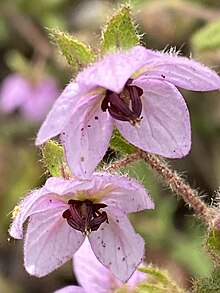| Thomasia petalocalyx | |
|---|---|

| |
| In Great Otway National Park | |
| Scientific classification | |
| Kingdom: | Plantae |
| Clade: | Tracheophytes |
| Clade: | Angiosperms |
| Clade: | Eudicots |
| Clade: | Rosids |
| Order: | Malvales |
| Family: | Malvaceae |
| Genus: | Thomasia |
| Species: | T. petalocalyx
|
| Binomial name | |
| Thomasia petalocalyx | |

Thomasia petalocalyx, commonly known as paper flower,[2] is a species of flowering plant in the family Malvaceae and is endemic to southern Australia. It is a shrub with wrinkled, oblong to egg-shaped leaves and cup-shaped mauve flowers.
Description[edit]
Thomasia petalocalyx is a shrub that typically grows to 0.5–1.5 m (1 ft 8 in – 4 ft 11 in) high, 0.5–2 m (1 ft 8 in – 6 ft 7 in) wide and has its new growth covered in star-shaped hairs. The leaves are oblong to egg-shaped, 20–40 mm (0.79–1.57 in) long and 5–13 mm (0.20–0.51 in) wide on a petiole 2–8 mm (0.079–0.315 in) long with hairy brown, wing-like stipules 8–12 mm (0.31–0.47 in) long at the base of the petioles. The leaves are covered with star-shaped hairs, and the edges are wrinkled, turned down and finely toothed. The flowers are arranged singly or in racemes of up to 5 on a red peduncle 30–40 mm (1.2–1.6 in) long near the ends of the branches. Each flower is on a pedicel 6–8 mm (0.24–0.31 in) long, with 3 bracteoles 5–6 mm (0.20–0.24 in) long at the base. The sepals are mauve and form a cup-shaped flower 10–15 mm (0.39–0.59 in) wide, the petals deep red and tiny.[2][3][4][5]
Taxonomy[edit]
Thomasia petalocalyx was first formally described in 1855 by Ferdinand von Mueller and the description was published in his book Definitions of rare or hitherto undescribed Australian plants.[6][7] The specific epithet (petalocalyx) refers to the petal-like sepals.[3]
Distribution and habitat[edit]
Paper flower grows in forest, woodland, coastal heath and on granite outcrops in the Esperance Plains, Jarrah Forest and Mallee bioregions of southern Western Australia, in the south-east of South Australia, including on Kangaroo Island, and in scattered locations in the west and south-west of Victoria, with an isolated population on Wilsons Promontory, where it is common.[2][3][4][5]
References[edit]
- ^ "Thomasia petalocalyx". Australian Plant Census. Retrieved 17 February 2023.
- ^ a b c "Thomasia petalocalyx". FloraBase. Western Australian Government Department of Biodiversity, Conservation and Attractions.
- ^ a b c Blake, Trevor L. (2021). Lantern bushes of Australia ; Thomasias & allied genera : a field and horticultural guide. Victoria: Australian Plants Society, Keilor Plains Group. pp. 46–47. ISBN 9780646839301.
- ^ a b Short, Philip S.; Stajsic, Val. "Thomasia petalocalyx". Royal Botanic Gardens Victoria. Retrieved 17 February 2023.
- ^ a b "Thomasia petalocalyx". State Herbarium of South Australia. Retrieved 17 February 2023.
- ^ "Thomasia petalocalyx". Australian Plant Name Index. Retrieved 10 December 2020.
- ^ von Mueller, Ferdinand (1855). Definitions of rare or hitherto undescribed Australian plants. Melbourne: Goodhugh & Tembath. pp. 2–3.